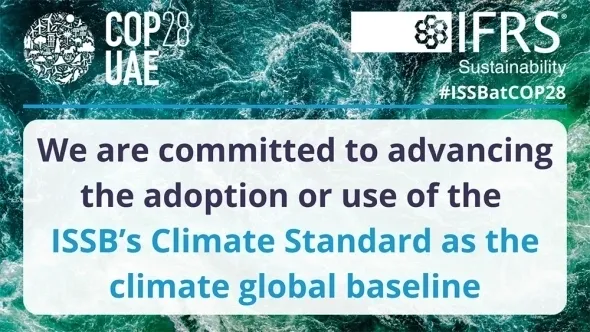IFRS S1 and S2 Standards: Game Changers in ESG Reporting
In the wake of COP28 in Dubai, a clarion call for action on climate risks and capital impact has resonated across the globe. The conference underscored the urgent need for consistent, comparable climate-related disclosures at an international level. This backdrop sets the stage for the transformative rollout of the IFRS S1 and S2 standards, a response aligning with the global momentum for enhanced ESG reporting.
IFRS statement on global adoption of ISSB’s SASB standards during COP 28
Finalized by the International Sustainability Standards Board (ISSB) on June 26, 2023, these standards represent a pivotal moment in the standardization of global corporate sustainability reporting. The ISSB, now part of the IFRS Foundation, has been instrumental in standardizing global financial reporting. Its involvement signals a new era of enhanced standardization and comparability in ESG disclosures. The IFRS S1 focuses on general sustainability reporting requirements, while IFRS S2 zeroes in on climate-related disclosures. Together, they aim to serve a broad spectrum of stakeholders, including global securities regulators, by emphasizing the financial materiality of businesses’ ESG information.

Impact on Canadian Businesses
As the IFRS S1 and S2 standards gain global traction, Canadian businesses face a critical shift towards more transparent and consistent sustainability reporting. The rapid adoption of these standards in the US market indicates a significant impending impact on Canadian firms, highlighting the urgency for alignment with these evolving standards. Central to this alignment are the SASB standards, which provide a practical pathway for companies to meet the new global reporting norms.
SASB Standards: The Key to Aligning with IFRS S1 and S2
The integration of SASB standards into the IFRS S1 and S2 represents a significant stride in the ESG reporting landscape, providing a practical pathway for companies to align with global reporting norms. Specifically, IFRS S1, which focuses on general sustainability reporting requirements, encourages companies to use SASB standards to identify and report on sustainability-related risks and opportunities. Similarly, IFRS S2, dedicated to climate-related disclosures, aligns with SASB’s approach to reporting on climate risks in different industries. Hence compliance with the IFRS S1 and S2 would mean the use of SASB standards in ESG disclosure.
Understanding SASB Standards
SASB standards provide detailed guidance for businesses to disclose financially material sustainability information. Organized by industry, these standards feature “Disclosure Topics” that highlight areas of financial materiality. Each topic is paired with “Accounting Metrics” for quantitative or qualitative reporting, supplemented by “Activity Metrics” for added context.
Example: Water Usage in the Beverage Industry
Consider a beverage company reporting its annual water withdrawal as an “Accounting Metric” – say, 10 million gallons. To contextualize this, the company also reports an “Activity Metric”: three of its ten facilities are in water-stressed regions. This combination of metrics allows stakeholders to understand the implications of the company’s water usage more comprehensively.
Investor Use of SASB Metrics
Investors use these metrics to assess a company’s management of risks and opportunities related to each Disclosure Topic. Efficient water management, especially in water-stressed areas, can be a positive indicator of sustainable practices, influencing investment decisions.
So, this is how SASB standards are like having a custom playbook for sustainability reporting, tailored just for your industry. But here’s the million-dollar question: How do you put this playbook into action?
Implementing SASB Standards in Reporting
The process involves several key steps:
I) Aligning on the “Why”
- Engage internal stakeholders to unearth diverse motivations driving your company’s sustainability efforts
- Document a clear sustainability mission aligned with the overall business strategy.
2) Understanding Your Reporting Environment
- Conduct a thorough assessment of your current sustainability reporting practices and regulatory requirements.
- Seek insights from your industry peers or industry ESG leaders.
3) Creating Organizational Buy-In
- Secure leadership buy-in to ensure that sustainability is a priority at the highest level.
- Establish a sustainability committee with representatives from various departments
4) Determining Your Audience and their needs
- Identify the specific information needs of your stakeholders through surveys or focus groups.
5) Establish Data Needs and Perform a Gap Analysis
- Determine the sustainability data that is most relevant to your company and stakeholders
- Perform a gap analysis to pinpoint discrepancies between your current data collection and what is required under SASB standards.
6) Ensure Reliable Information
- Regularly validate the accuracy of your sustainability data. Implement robust systems for detecting and correcting data anomalies.
- Involve your board and audit committee in the sustainability reporting process.
- Consider establishing data assurance procedures, either internally or through external verification
7. Handling Omissions, Additions, and Modifications:
- Maintain transparency by clearly communicating any changes in your reporting parameters.
By following the above steps, companies can effectively integrate SASB standards into their reporting, enhancing the credibility and integration of IFRS S1 and S2 standards into their sustainability disclosures.
At YellowYellow, we’re not just about transforming ESG reporting; we turn it into a dynamic asset that propels your business forward. Fed up with one-size-fits-all solutions and hefty price tags? Our team, featuring three (3) FSA SASB-trained associates, is dedicated to crafting a bespoke journey tailored to your unique operational needs. We’re here to elevate your sustainability narrative, ensuring it resonates with your values and vision. Let’s collaborate to elevate your sustainability narrative and drive meaningful change. Reach out to hello@yellowyellow.ca to get started!
References
- IFRS Foundation, “IFRS S1 and S2 Standards Overview.” Link
- Image credit : COP 28 & IFRS image credit : https://www.ifrs.org/news-and-events/news/2023/12/issb-at-cop28-statement-of-support/
- Deloitte, “Global ESG Disclosure Standards Converge: ISSB Finalizes IFRS S1 and IFRS S2.” Link









